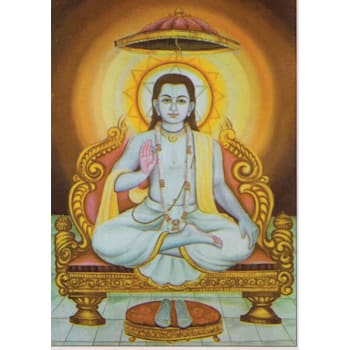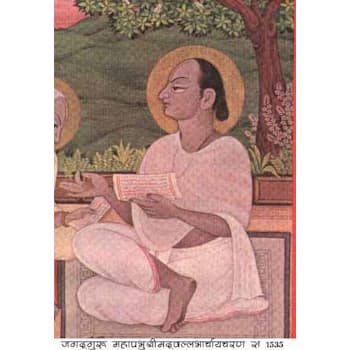Notes from Bhakti School of Vedanta by Tapasyananda
After listening and reading to the introductory Advaita Vednata book, Vedanta Saara, I was intrigued to understand the core teachings of the alternative schools. In his talk, Swami Sarvapriyananda had spoken about the book, Bhakti Schools of Vedanta. I was fortunate enough to find a copy and some time to read through it. Here are some quick notes from this book.

The common object of all these systems may be stated thus: They seek to establish the supremacy of the Divine Personality, known under the different sacred names of Purushottama, Narayana, Vasudeva, Krishna, etc. and equate Him with Brahman the Absolute of the Upanishads. For them, the Supreme Being is Person with atributes and there is no Absolute beyond Him. They also lay stress on the exclusive position of devotion and Divine grace as the only means to overcome the hold of Karma on the Jiva and enable him to attain salvation. Salvation or release from the hold of Karma does not mean for them the mergence of the Jiva in Brahman, but attaining to the status of an eternal servant of His, which alone can give unalloyed bliss to the Jiva. Most of these teachings are theological… p31
All the Vaishnava schools accept the nine forms of devotional disciplines mentioned in the Bhagavata Purana:
- Shravana hearing recitals and expositions of divine excellences
- Kirtana choral singing of the Lord’s praise
- Smarana constant remembrance of Him through Japa, meditation, etc.
- Paadaseva service of the world recognizing it as a Paada or aspect of God
- Archana worship of Him in images
- Vandana salutation which consists in an attitude of genuine courtesy to all as temples of God
- Dasya cultivating the attitude that one is servant of God
- Sakhya sense of intimacy with Him
- Atmanivedana surrender of one’s self and everything to him. p231
Sri Ramanuja Philosophy

Theory of creation and problem of evil
There is no absolute originals as souls (Jivas) and changeful nature (Jagat) always exist as a part of Brahman as His body or mode. They exist in the two states of latency (Pralaya) and patency (manifestation or Sristi). Pralaya and Sristi are eternally continuing states of universal Nature like night and day.. p43
Being an eternally recurring cyclic process, God is free from the responsibility of starting it and causing the evils accruing from it. It is Karma, the result of the action of Jivas in previous embodiments, that causes the good and evil, enjoyments and sufferings of Karma which have got necessarily to be enjoyed or suffered by those responsible for them. God does not create those efficiencies as He does not create Nature… God only provides the manifestation power. He is not responsible for the evil and sufferings involved in the creating process.
Knowledge for the Jiva consists in his recognition of his being only an absolutely dependent entity whose purpose is only to serve the Lord and not gain any personal enjoyment apart from it. p46
Unlike in Sankara’s system, there is nothing like subject-objectless consciousness in Visistadvaita metaphysics. Such a conception is dubbed as a metaphysical fiction. p56
Freedom of will
(My summary) In this system, God only wills fruictification of Karma accrued by the Jiva. God is like light - it can be used for forging or reading scriptures. The merit or demerit devolves entirely on the person concerned and not on the light. The Jiva when it identifies with body-mind may accrue bad Karma. Knowledge is identification of the Jiva as only a Sasira (body) of God and he is a Sesa (servant) of Lord will all the actions be burnt in the fire of knowledge.
.. the most intimate and personalized name for the Supreme Being is Naraayana synonymous with Vishnu. Naraayana means He who is the ayana (dwelling place) i.e. the source, support and dissolving ground of all Naras or Jivas including inert matter too. p69
Problem of Theology
In the Semitic religions which uphold the idea of a formless God with human attributes, religion becomes gradually the acceptance of certain dogmas and social practices. Prayers become petitions addressed to some vague entity. Gradually social cohesion and not spiritual experience, becomes their aim and religion becomes highly politicized.
Sri Nimbraka

Termed as द्वैताद्वैत, this philosophy is called duality in unity and is very similar to the भेदाभेद (Bhedaabheda) philosophy of Bhaskara adopted to the Vaishnava theology.
Bhaskara criticized the two tiers of Reality, the really real पारमार्थिक (Paramaarthika) vs the apparently real व्यवहारिक (Vyavahaarika). He claimed that this is not mentioned in the Upanishads and was adopted from the शून्यवाद (ie Nihilistic school of Buddhism).
For Nimbraka,
God is essentially formful and the substrate of all auspicious attributes. When the Upanishads speak of Him as nirguna, it only means that He is not subject to the Gunas or Prakriti. So also nirvishesha (without attributes) means He is without attributes born of neiscience as in the case of wordly objects to whom those attributes are limitations. p94
Kinds of Jivas
Though all Jivas are potentcies of Brahman, Nimbraka’s system recognizes a kind of Taratmaya, gradation, among them. Some of them are Nityamuktas or eternally free. They had never been in bondage. They are eternally engaged in Divine service as His ornaments.. Then there are the bound souls, Baddhas. Some of them are मुमुक्षु (Mumukshus) or seekers after libration striving for that consummation. There are also some others oblivious to spiritual values and are wallowing in worldliness. They are Nitya-baddhas, the eternally bound. p97
Sri Madhavacharya

Dvaita Philisophy
Madhava
preferred to call his system emphaticaly as pure dvaita (Dualism) - the doctrine of Reality as having two aspects the स्वतन्त्र (svatantra / Independent) and the परतन्त्र (paratantra / Dependent). The Independent is God or Brahman, and the Dependent are the Jiva (soul), Prakriti (Primordial Matter) and other ontological entities. The difference between the Independent and the Dependent is complete and eternal, as it is the basic and irrevocable nature of Reality. p128 The Dvaita is further elaborated into पञ्च बेध (5-fold difference). The 5 differences are between:
- Jiva and Jiva
- Ishvara and Jiva
- Ishvara and Jada
- Jada and Jiva
- Jada and Jada (p144)
Metaphysics
Madhava defines a valid sense experience as यथार्थ (yathartha), knowledge of facts as they are. The fact experienced may rapidly or slowly undergo change, but that does not subtract from its reality. Permanence of any nature is not necessary for any entity to be real.
In Madhava’s system of realism, consciousness is always bi-polar - that is, there must be a knower ज्ञाता (jnaata) at one end, and an object ज्ञेय (gneya) at the other end. There is nothing like subject-objectless consciousness. This holds true for dreamless sleep.
The significance of this is that there are two types of objective perception - one through the meditation of the mind alone and the other through sense contacts with outside objects. p129
Theory of Evil
(My summary)
In Madhava’s system, the Independent and Dependent co-exist and the Dependent is not generated by Him from Himself.
In Dualism, avidya (ignorace) is located in the dependent Jiva and does not affect the Brahman in any way. So there is no need for a concept like Maya.
- Ramanuja - all Jivas are same after liberation
- Madhva - Jivas remain different even after liberation
Doctrine of Salvation
Unlike in some the other systems of Vedanta, Sravana and Manana are only subsidiary to Nidhidyaasana in Madhva’s system.
Why Madhvas argue so much?
A competent Guru has to give proper criticism of other opposing systems of thought, as intellectual vacillation of disciplines will not disappear otherwise. Due to this, Madhavas have been criticized for intellectual pugnacity and acrimonious attitude… According to them (Madhvas) unless systems opposed to Madhvism are criticized theradbare and their hollowness shown, one’s own faith in the true doctrine will not be unshakably established. This will no doubt engender an element of exclsiveness and fanaticism as in almost all forms of theism. (p185)
In Madhva’s system, scriptures hold value but experience trumps it. Even if scriptures say fire is cold, the experience is otherwise and this holds more value.
Sri Vallabha: द्वैताद्वैत (Shuddhatvaita )

Shuddhatvaita शुद्दत्वॆता means pure Non-dualism, purity consisting in that it does not accept Maya, a principle of illusion that has necessarily got to be conceived as outside Brahman. For, Brahman, who is Satcidananda, is truth unalloyed, and there can be no touch of illusion or falsity in Him. Maya can therefore be only His real power, producing real effects and not false appearances. This eschewal of Maya, as a principle or category of falsity, either internal or extraneous to Brahman, is the most important feature of Suddhadvaita. According to the system, the term Maya means the real power if it is conceived as within Him. If on the other hand it is conceived as outside of Him, it becomes a dual category of falsity compromising the doctrine of non-duality. p217
… Vallabha’s position is that Brahman Himself has manifested as the universe; but no change or transformation of any kind has come over His entity thereby. The world manifested by Him is actually there and not imagined to be there by any one because of Avidya. p220
Vallabha’s system is called ब्रह्मवाद (Brahma vaada) as opposed to Shankara’s system which is called as मायावाद (Mayavaada). In Shankara’s system, Maaya becomes more profound entity than Brahman.
In Vallabha’s system, scriptures are the sole authority on spiritual matters. Scriptures includes all sections of the Vedas (unlike Shankara who only accepts the Upanishads), Smriti literature like Vyaasa-sutra, Mahabharta, Gita, Pancaratra and Purana literature. In practice, Bhagavata Purana literature is the mainstay. p224
Akshara
Akshara is Sat-cid-ananda, with the Ananda aspect considerably concealed. he is lesser than Krishna, the Purushottama, who alone is Sat-cid-ananda in fullness. The Akshara is the Impersonal Being, with whom the Shuddadvaitin identifies the Brahman of Shankara’s system of Advaita. It is interesting to note that in Shankara’s system, the personal is the Apara Brahman (lower Brahman) and Impersonal, the Para Brahman (the Supreme Brahman). Here the tables are turned. p225
Sri Krishna Chaitanya

The philosophy taught by Sri Krishna Chaitanya is termed as Achintya-bhedabheda.
According to this school, Krishan is the Sat-Cid-Ananda Para-Brahman. Krishan is the Absolute Person. The indefinite awareness of anything is the first and most primitive and therefore the most peripheral, understanding of anything. When awareness becomes definite, clear and defined, then only anything is fully understood. This is true with regard to the Supreme Reality. The Bhagavan, the Divine Personality, clear and defined is the core of Reality, and the indefinite and unmodified Brahman can be only His peripheral brilliance.
The school is Inconceivable Identity-in-difference (Acintya-bhedabheda). According to this school, Shakti (power) is both identical and different from Shaktimat (powerholder). It is because of this element of difference that transformation of Sakti does not affect the Saktimat. At the same time, the element of identify makes the Supreme Reality Non-Dual even in the midst of difference. How these two contradictory features can co-exist is not attempted to be explained logically. For this reason, it is designated as Acintya - alogical or incomprehensible by thought. It means logic, which is ultimately based on sense experience, cannot bring it within its laws and it has therefore to be accepted as a fact transcending human understanding. p315
Generally in all other Hindu religious cults, Krishna is one of the incarnations of Vishnu, but the Bengal school of Vaishnavism makes Krishan the Godhead and Vishnu one of His emanations. p316
The concept of Bliss becomes meaningful only when it is a matter of self-realization or realization in an object. To speak of Brahman as Bliss in the sense that it is without sorrow, as certain philosophers do, is meaningless, because even a stone, being without sorrow, can be described as bliss in that sense. Bliss without self-awareness and awareness of others is meaningless and indistinguishable from mere inertness. So Sri Krishan, the Supreme Reality, is not only Rasa but also Rasika, the enjoyer of Bliss. p324
